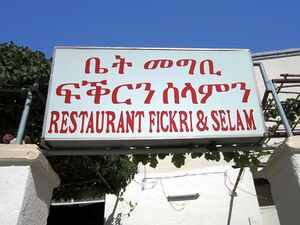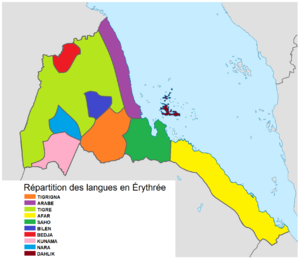لغات إرتريا
| لغات إرتريا[1] | |
|---|---|
 Restaurant with sign in Tigrinya and English (Keren, Eritrea) | |
| اللغة الرئيسية | Tigrinya, Tigre, Kunama, Bilen, Nara, Saho, Afar, Beja[1][2] |
| اللغات الأجنبية الرئيسة | Italian, English, Arabic |
| لغة الإشارة | Eritrean Sign Language, older sign languages |
| Common keyboard layout(s) |  |
| جزء من سلسلة عن |
| ثقافة إرتريا |
|---|
 |
| التاريخ |
| اللغات |
| المطبخ |
|
|
يتحدث الشعب الإرتري تسع لغات تتوزع على تسع قوميات ينتشرون في طول البلاد وعرضها، من هذه القوميات: التجراي والتيجرينية التي ينتمي إليها الرئيس إسياس أفورقي ومعظم أعضاء حكومته، والعفر والسامو والنارا والحضارب والرشايدة العربية الأصل والبلين والكوناسا، إلا أن اللغتين الأكثر انتشاراً هما التيجرية والعربية، وتتشابه التيجرية إلى حد بعيد في جذورها مع العربية؛ حيث انحدرت من أصول سامية من شبه الجزيرة العربية.
ويتحدث سكان إرترية لغات متعددة متقاربة الأصول، تتمثل على نحو أساسي باللغتين «التغرينية» و«التغرية». وتشير المصادر التاريخية إلى أن هاتين اللغتين اشتقتا من اللغة الجعزية السبئية، وتتشابهان إلى حد بعيد مع لهجة سكان ظفار ولجهة سكان المحافظة السادسة من جمهورية اليمن. واللغة التغرينية أقرب إلى اللغة الجعزية السبئية من أختها التغرية وتكتب بحروفها، وهي أكثر اللغات انتشاراً من حيث عدد المتحدثين بها، وجلهم من النصارى وبعض المسلمين من سكان الهضبة الإرترية. أما اللغة التغرية فتنتشر في شرقي إرترية وشماليها وغربيها، وغالبية المتحدثين بها من المسلمين، ويتكلم بعض قبائل «بني عامر» اللغة «البجاوية» التي تسمى «البداوي» في حين تتحدث قبائل البازا والباريا لغة نيلية إفريقية، وتمثل اللغة العربية القاسم المشترك بين مجموع هذا التعدد اللغوي الواسع، وغالباً ما يجري التفاهم بالعربية بين الجماعات التي لا يعرف بعضها لغة بعضها الآخر، إضافة إلى الجماعات التي تتحدث العربية وحدها مثل الرشايدة. وقد اتخذ البرلمان الإريتري، قبل أن يحله الإثيوبيون، من اللغة العربية لغة رسمية لإريترية إلى جانب اللغة التغرينية بحسب المادة 38 من الدستور الإريتري، وكانت اللغتان العربية والتغرينية تدرسان في المدارس قبل أن تمنع ذلك إثيوبية، ومما ساعد على اقتصار التعليم بهاتين اللغتين فحسب كونهما الوحيدتين اللتين تمكن الكتابة بهما.
إلا أن الغالبية العظمى من السكان تفضل استخدام اللغة العربية؛ لارتباطها بالدين والتراث الإسلامي؛ حيث إن أغلب سكان إرتريا مسلمون، كما أنها لا تزال اللغة الرسمية في دواوين الدولة والإذاعة والتلفزيون والصحيفة الرسمية الناطقة باسم الدولة، وهي صحيفة إرتريا الحديثة.
قد قامت الحكومة بإغلاق العديد من مدارس اللغة العربية في إقليم عشبا غرب العاصمة الإرترية، وإجبار مدارس أخرى على تدريس العلوم باللغة التيجيرية بدلاً من العربية.
وفي منطقة عفر ذكر بعض الأهالي أن الحكومة تعمل على وضع قواعد جديدة، واختراع حروف أخرى للغة العفر بدلاً من تلك المستعملة في جيبوتي وإثيوبيا منذ مائتي عام، وقال هؤلاء الأهالي إن الهدف من ذلك هو عزل القومية العفرية عن امتدادها في جيبوتي والصومال وإثيوبيا.
وكانت إثيوبيا التي احتلت إريتريا حتى عام 1993 قد حاولت في الماضي فرض اللغة الأمهرية التي تتحدث بها على الشعب الإريتري لكنها فشلت في ذلك وجوبهت بمقاومة عنيفة، وكانت من جملة أسباب اندلاع الحرب بينهما في أعوام 1991 و1993 و 1998.
الديمغرافيا العرقية-اللغوية
According to linguists, the first Afroasiatic-speaking populations arrived in the region during the Neolithic period from the family's proposed urheimat ("original homeland") in the Nile Valley,[3] or the Near East.[4] Other scholars propose that the Afro-Asiatic family developed in situ in the Horn, with its speakers subsequently dispersing from there.[5]
Eritrea's population now comprises nine ethnic groups, most of whom speak languages from the Semitic and Cushitic branches of the Afro-Asiatic family.[6]
Estimates of numbers of speakers given below are from SIL Ethnologue unless otherwise noted.
Afro-Asiatic languages
The languages spoken in Eritrea are Tigrinya, Tigre, and Dahlik (formerly considered a dialect of Tigre). Together, they are spoken by around 70% of local residents:
- Tigrinya, spoken as a first language by the Tigrinya people. As of 2006, there were around 2.54 million speakers.
- Tigre, spoken by the Tigre people. As of 2006, there were around 1.05 million speakers.
- Dahlik, spoken in the Dahlak Archipelago. Variously regarded as either a divergent dialect of Tigre or a separate language, it was recently assigned its own ISO 639-3 code. As of 2012, there were around 2,500 speakers.
Other Afro-Asiatic languages belonging to the family's Cushitic branch are also spoken in the country.[6] They are spoken by around 10% of residents and include:
- Beja (Bedawiyet), spoken by the Hedareb. It is sometimes classified as an independent branch of the Afro-Asiatic family. As of 2006, there were 158,000 speakers in Eritrea.
- Saho, spoken by the Saho people. It is sometimes grouped with Afar as Saho-Afar. As of 2006, there were around 789,000 speakers in Eritrea.
- Afar, spoken by the Afar people, predominantly in Ethiopia and Djibouti. As of 2006, there were fewer than 100,000 speakers in Eritrea.
- Blin or Belin, spoken by the Bilen people in the Anseba region and Keren town area. As of 2006, there were around 91,000 speakers.
- Amharic
Nilo-Saharan languages
In addition, languages belonging to the Nilo-Saharan language family are spoken as a mother tongue by the Kunama and Nara Nilotic ethnic minorities that live in the west and southwestern parts of the country. Around 187,000 individuals speak the Kunama language, while around 81,400 people speak the Nara language. As of 2006, this corresponds with around 3.5% and 1.5%, respectively, of total residents.[6]
اللغات الأجنبية
Arabic is mostly found in the form of Modern Standard Arabic as an educational language taught in primary and secondary schools, but there are native speakers of dialectal variants of Arabic, as follows:
- Sudanese Arabic; spoken by approximately 90% of Arabic speakers of Eritrea, also spoken by Sudanese Arabs.
- Hijazi Arabic, spoken by the Rashaida. As of 2006, there were around 24,000 speakers.
Italian was introduced in the 19th century by the colonial authorities in Italian Eritrea but is now used in commerce at times. It serves as the mother tongue of a few Italian Eritreans, but is still understood and spoken as a "pidgin" [7] by many old Eritreans mainly in Asmara and Massawa.
English was introduced in the 1940s under the British military administration of Italian Eritrea. It is now used as the de facto working language.[بحاجة لمصدر]
انظر أيضا
المصادر
- ^ أ ب Hailemariam, Chefena; Kroon, Sjaak; Walters, Joel (1999). "Multilingualism and Nation Building: Language and Education in Eritrea" (PDF). Journal of Multilingual and Multicultural Development. 20 (6): 474–493. doi:10.1080/01434639908666385. Archived from the original (PDF) on 2015-09-23. Retrieved 2012-04-04.
- ^ "Africa :: Eritrea — The World Factbook - Central Intelligence Agency". www.cia.gov. Archived from the original on June 12, 2007.
- ^ Zarins, Juris (1990), "Early Pastoral Nomadism and the Settlement of Lower Mesopotamia", (Bulletin of the American Schools of Oriental Research)
- ^ Diamond J, Bellwood P (2003) Farmers and Their Languages: The First Expansions SCIENCE 300, DOI:10.1126/science.1078208
- ^ Blench, R. (2006). Archaeology, Language, and the African Past. Rowman Altamira. pp. 143–144. ISBN 0759104662. Retrieved 8 September 2014.
- ^ أ ب ت Minahan, James (1998). Miniature empires: a historical dictionary of the newly independent states. Greenwood Publishing Group. p. 76. ISBN 0313306109.
The majority of the Eritreans speak Semitic or Cushitic languages of the Afro-Asiatic language group. The Kunama, Baria, and other smaller groups in the north and northwest speak Nilotic languages.
- ^ Eritrean Pidgin Italian was developed during colonial times
- Woldemikael, Tekle M (2003). Language, Education, and Public Policy in Eritrea "Language, Education, and Public Policy in Eritrea". African Studies Review. 46: 117. doi:10.2307/1514983. Retrieved 2007-01-27.
{{cite journal}}: Check|url=value (help); Unknown parameter|month=ignored (help)
